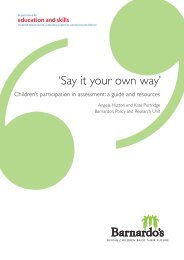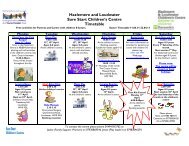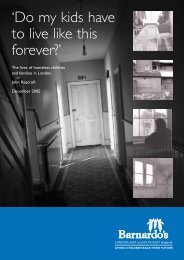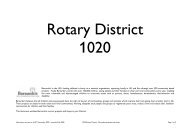Splintered Lives - Barnardo's
Splintered Lives - Barnardo's
Splintered Lives - Barnardo's
You also want an ePaper? Increase the reach of your titles
YUMPU automatically turns print PDFs into web optimized ePapers that Google loves.
PAGE 16<br />
chapter<br />
5<br />
There is already some evidence that the distinction between these traditional forms and<br />
commercial sexual exploitation is increasingly murky (See O'Grady, 1994, p89).<br />
Defining pornography, prostitution and trafficking beyond the above caveats is also<br />
fraught with problems. Pornography includes magazines, films, videos, computer<br />
material and still photography. The argument has frequently been made that during the<br />
1970s and 1980s the commercial child pornography sector declined, due to both<br />
legislative and enforcement responses, but that 'home' produced material is more<br />
widespread. Keith Driver (1995) of the Obscene Publications Squad referred to it as<br />
primarily a 'cottage industry', This distinction turns on a particular definition of<br />
'commercial' - as intentionally produced for sale/profit. But once material is reproduced<br />
and distributed or exchanged it ceases to be private. Once it enters the public sphere the<br />
potential for it to become 'commercialised' exists, either in terms of personal gain, or<br />
being passed on to someone else who chooses to use it for monetary profit. The<br />
technology which is now available to individuals is sophisticated, and 'cottage industry'<br />
suggests using now out dated methods. Perhaps the better analogy is to illegal drugs,<br />
where an informal and unregulated market exists, making accurate assessments of the<br />
extent of production, exchange and sale extremely difficult. Whilst we are not in a<br />
position to compare the relative sizes of the two informal markets, it is likely that the<br />
extent of, and revenue from, sale of illegal drugs exceeds that of sexual exploitation of<br />
children.<br />
Also at issue here, as with adult pornography, is whether sexualised images of children,<br />
or 'innocent' pictures with sexually suggestive captions/words, used in mainstream<br />
media should be included. Additionally the ways in which more mainstream media and<br />
so called 'soft core' adult pornography deliberately 'childify' adult women needs to be<br />
addressed. Part of the appeal of the 'topless' models on Page 3 of the British tabloid<br />
The Sun 10 is that the pictures are of young women, and a number of the mainstream<br />
newspapers which publish such pictures tantalise their male readers with promises of<br />
'future attractions' - Le. young women they cannot show topless as they are not yet 16.<br />
Playboy developed a particularly devious way of publishing pictures of children:<br />
including photos of the centrefold 'Playmate' as a child, with captions like 'Age one -<br />
Playboy material already', 'Age two - boy chasing already', 'Age three - any time Dad'<br />
(Reisman, 1986). Another study analyzed all cartoons in Playboy in 1985, and found that<br />
child like naivete of women was a key theme (Matacin and Burger, 1987).<br />
At both seminars which informed this document Cathy Itzin (1995) presented the harmbased<br />
definition of pornography developed by the British Campaign Against<br />
Pornography and Censorship. In the case of child pornography, however, it is not<br />
necessary currently to prove harm in the same way that it is for material which uses<br />
adults. To adopt this definition in relation to children would in the current<br />
circumstances confuse rather than enlighten, but having a harm-based definition which<br />
replaced the current 'obscenity' test for all pornography would shift the focus of<br />
legislation and enforcement in a positive direction. Osanka and Johann (1989, p451)<br />
………………………………………………………………………………………………………<br />
10 In the late 1980s, Page 3 of The Sun, a British daily tabloid newspaper, became a focus for feminist campaigning, when Clare<br />
Short MP put forward a private members bill to ban 'photographs of naked or semi-naked women in national newspapers'<br />
(1987) and received a great deal of popular support as a result. A feminist anti-pornography campaign was launched from the<br />
momentum gained during this period, although the bill was eventually talked out<br />
"
















